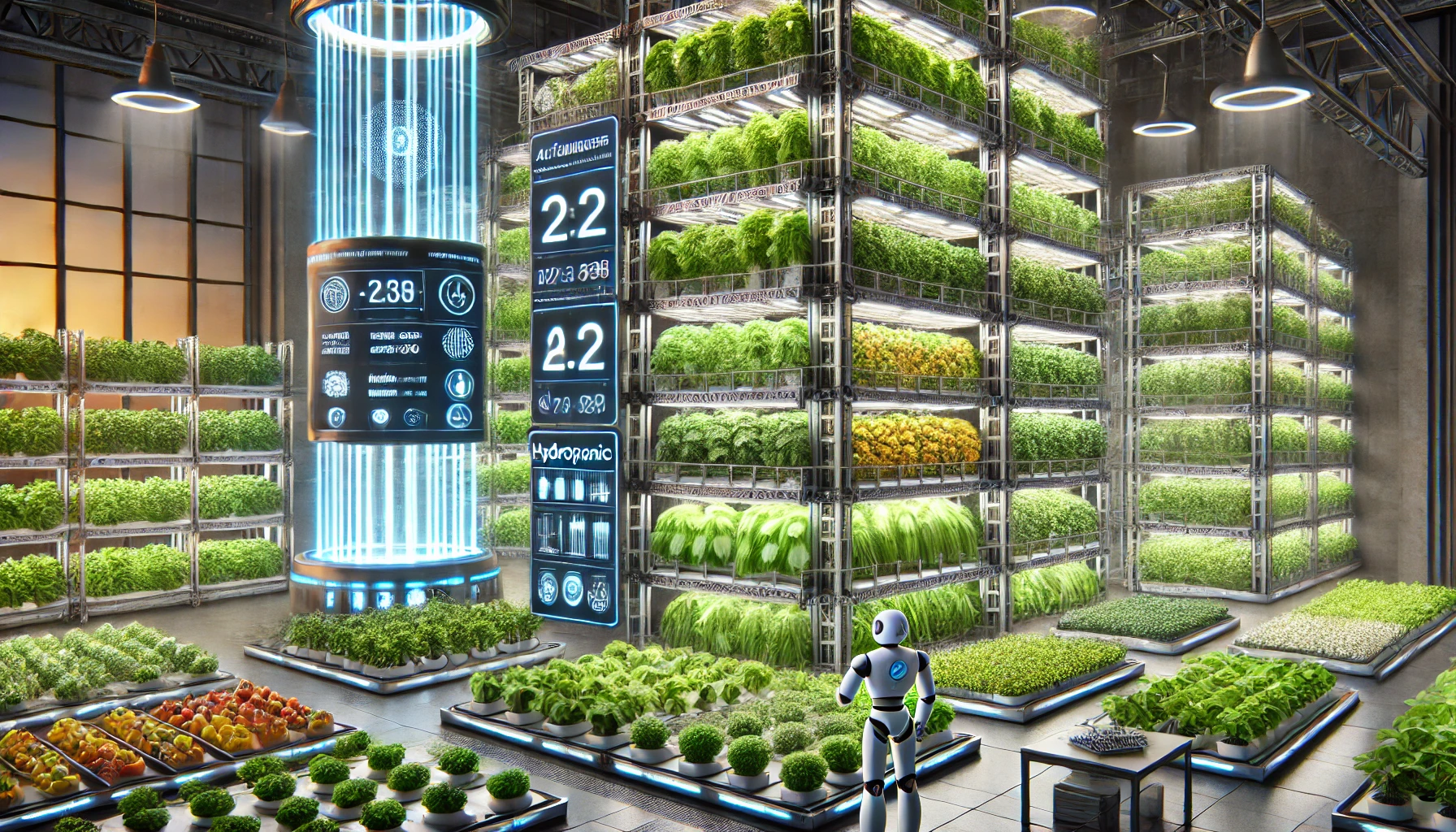As the world’s urban population continues to grow, traditional agriculture faces space limitations, resource constraints, and supply chain inefficiencies. Cities require sustainable, high-yield food production methods that can reduce environmental impact while meeting increasing demand. Urban vertical farming, powered by Artificial Intelligence (AI) and smart technology, is emerging as a game-changing solution to grow food efficiently in urban areas.
Vertical farming utilizes stacked growing systems, hydroponics, aeroponics, and AI-driven automation to maximize space, water efficiency, and crop production. By integrating AI-powered monitoring, robotics, and climate control, urban farms are producing fresh, high-quality food year-round with minimal waste.
In this article, we explore how AI is transforming urban vertical farming, the best technologies driving indoor food production, and how these innovations are shaping the future of sustainable urban agriculture.
1. The Challenges of Traditional Urban Food Supply
1.1. Limited Space for Farming
- Urban areas have little available farmland, making traditional agriculture impractical.
- AI-powered vertical farms use stacked layers to maximize food production per square meter.
1.2. High Transportation Costs and Food Waste
- Most food in cities travels hundreds or thousands of miles, increasing carbon emissions and spoilage rates.
- Urban farms reduce transportation costs and food waste by producing food locally, near consumers.
1.3. Unpredictable Weather and Climate Change
- Outdoor farming is vulnerable to extreme weather events, droughts, and temperature fluctuations.
- AI-driven vertical farms use fully controlled indoor environments, ensuring consistent food production year-round.
1.4. Water and Resource Scarcity
- Traditional agriculture consumes 70% of global freshwater resources.
- Smart irrigation and AI-powered hydroponics reduce water use by up to 95%.
1.5. Labor Shortages and High Operating Costs
- Urban farms struggle with manual labor costs and skill shortages.
- AI-driven automation reduces labor dependency and increases efficiency.
2. How AI is Transforming Urban Vertical Farming
AI-powered vertical farms integrate machine learning, automation, and sensor-driven analytics to optimize crop production, resource use, and sustainability.
2.1. AI-Driven Climate Control Systems
- AI monitors temperature, humidity, CO₂ levels, and lighting to create ideal growing conditions.
- Automated ventilation and nutrient delivery systems adjust settings in real time.
Examples of AI-powered climate control:
- Intelligent Growth Solutions (IGS) – AI-driven vertical farming climate automation.
- Priva Smart Climate Systems – Uses AI to control temperature, humidity, and air circulation.
- Agrilyst AI Analytics – Monitors and optimizes indoor farm environments.
2.2. AI-Powered Hydroponics and Aeroponics
- Smart hydroponic systems grow plants in water-based nutrient solutions, eliminating soil use.
- AI adjusts nutrient levels, pH balance, and oxygen supply for maximum plant health.
Examples of AI-driven hydroponic systems:
- AeroFarms AI Farming System – Uses machine learning to optimize nutrient delivery in hydroponics.
- LettUs Grow Aeroponic Farming – AI-controlled mist-based plant nutrition system.
- Gotham Greens AI Greenhouse – AI-powered urban farming system using hydroponics.
2.3. AI and Robotics for Crop Monitoring and Automation
- AI-powered cameras and sensors analyze plant growth, detect diseases, and predict harvest timing.
- Robotics automate planting, pruning, and harvesting, reducing manual labor costs.
Examples of AI-driven automation in urban farming:
- Iron Ox Autonomous Vertical Farm – AI-powered robotic farm with self-learning crop care.
- Octinion Strawberry Harvesting Robot – AI-driven soft-touch harvesting for delicate crops.
- Eden Green AI Vertical Farming – Uses AI to monitor plant health and optimize yield.
2.4. AI-Optimized LED Grow Lights for Energy Efficiency
- AI-powered full-spectrum LED lighting mimics natural sunlight, optimizing photosynthesis.
- Automated light cycles reduce energy consumption and improve plant growth.
Examples of AI-driven LED lighting:
- Fluence Bioengineering LED Systems – AI-controlled energy-efficient grow lights.
- Heliospectra Smart Grow Lights – Adaptive LED lighting for different plant growth stages.
- Philips Horticulture LED Solutions – AI-powered customizable light spectrum control.
2.5. AI-Powered Pest and Disease Control
- AI monitors plants for early signs of disease, nutrient deficiencies, and pest activity.
- Automated treatment systems apply organic solutions only when needed, reducing pesticide use.
Examples of AI-driven pest control:
- Taranis Precision Pest Management – AI-powered drones for early detection of plant diseases.
- EcoRobotix Smart Weeding Robot – AI-driven precision herbicide application.
- CropX AI Soil and Plant Health Monitoring – Predicts disease risks based on environmental data.
3. The Benefits of AI in Urban Vertical Farming
3.1. Higher Yields in Less Space
- AI-powered vertical farms produce up to 30 times more food per square meter than traditional farms.
3.2. Reduced Water and Energy Consumption
- AI optimizes water recycling systems, reducing usage by up to 95%.
- Smart LED lighting cuts energy costs while maintaining optimal plant growth.
3.3. Year-Round Food Production
- AI-controlled greenhouses eliminate seasonal dependency, ensuring constant food supply.
3.4. Lower Environmental Impact
- AI-driven automation reduces food waste, transportation emissions, and pesticide use.
3.5. Fresher, More Nutritious Produce for Urban Consumers
- Locally grown food reaches consumers within hours instead of days, preserving freshness and nutrients.
4. The Future of AI in Urban Vertical Farming
4.1. Fully Autonomous AI-Run Vertical Farms
- Future farms will operate without human intervention, using AI-controlled robots for planting, monitoring, and harvesting.
4.2. AI-Enhanced Personalized Nutrition Farming
- AI will customize nutrient-rich crops based on consumer dietary needs, improving food quality.
4.3. AI-Integrated Blockchain for Food Traceability
- AI and blockchain will ensure full transparency from farm to table, tracking food quality and sustainability.
4.4. Net-Zero Energy Urban Farms
- AI will optimize solar-powered farms and energy-efficient urban agriculture systems.
Conclusion: AI is the Future of Urban Food Production
AI-powered urban vertical farming is redefining food production, making cities self-sufficient, sustainable, and food-secure. Whether through AI-driven climate control, hydroponics, smart lighting, or robotic automation, technology is enabling high-efficiency urban farms to feed growing populations.
As AI continues to evolve, urban vertical farms will become fully autonomous, eco-friendly, and capable of growing diverse crops in any environment, securing the future of sustainable city farming. Now is the time to embrace AI-driven urban agriculture for a smarter, greener, and healthier world! 🚀🌇🌿

